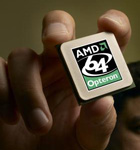Once a duo, now a quartet: What quad-core processors can do
Munich -  It's no longer quite right to speak of a processor in terms of a single chip. The heart of a computer has long been composed of several chips and other elements on a circuit board, collectively called a processor.
It's no longer quite right to speak of a processor in terms of a single chip. The heart of a computer has long been composed of several chips and other elements on a circuit board, collectively called a processor.
To underscore the point, processors with two cores have now become common. And the evolution to the next level is well under way. Quad core processors are increasingly commonplace for private desktop PCs.
Why would a computer need four processing cores? Multiple core processing did not, in fact, develop as a way to pump up the speed of the machine, but rather in response to simple physics. Up until just a few years ago, the only way to boost processing power was to increase the tact frequency. The higher the tact frequency, however, the greater the power consumption and heat, explains Christof Windeck from the Hanover-based magazine c't.
At some point the manufacturers came upon the idea of putting multiple cores onto one processor. The result was less consumption with the same performance.
Most people probably won't notice a big difference in their power bill after switching to a desktop PC with multiple cores. What they will notice is how much quicker multi-core processors work compared with their single core brethren. The big advantage of multi-core computers is their ability to handle multiple tasks at once. That's needed primarily when multiple programs are running simultaneously. There are also individual programs that make good use of multiple cores.
"Sound plays a big role for games, for example," Windeck says.
Almost all computers currently on the market offer dual core processors, since few buyers have interest in the single core versions any more. "By the end of this year there won't be any single core processors left on the market," says Intel's Mike H. Cato. And because in the IT industry tends to make its leaps of progress in factors of two, the quad core is the logical continuation.
That doesn't necessarily mean that consumers should be in a hurry to acquire the new technology, however. The real-world performance improvement when moving from a dual to quad core processor is not that great, Windeck notes. That's because there are few programs at present that can use quad core processors efficiently, excepting a few specific professional applications.
Tests have also shown that when dual and quad core processors are offered at the same price, the dual core solutions are generally better, Windeck notes. The argument that a quad core processor is better prepared for the future is also specious: processor prices are falling so quickly that it makes more sense to buy the technology at the point in time when it's needed, not earlier.
Both Intel and AMD, the big processor makers, have quad cores at the top of their lineup. At Intel this includes the models of the Core 2 Quad series as well as the Core 2 Extreme. While the cheapest Quad (2.4 Gigahertz of processing speed) is available for a bit over 200 dollars, an Extreme model that runs at 3.2 GHz of processing speed runs 1300 dollars. For all the difference in those prices, the meagreness of the performance bump may disappoint some.
"In the high end area, you're paying a lot of money for a relatively small amount of extra performance," Windeck notes.
At AMD, the quad core processors for desktop PCs are named Phenom X4. They are available in speeds of 2.2 and 2.3 GHz and cost around 190 and 220 dollars respectively. AMD has also bridged the gap between the dual and quad. The Phenom X3 8400, with 2.1 GHz, and the 8600, with 2.3 GHz, each possess three cores.
The Triple Cores are primarily of interest for gaming and multimedia fans who want more performance than the eual cores but lower prices than for the quad cores. Windeck is skeptical, given that practical testing remains to be done: "The same holds true here: If it has more than two cores, you should have at least one application which can use more than one core for itself," he says. (dpa)